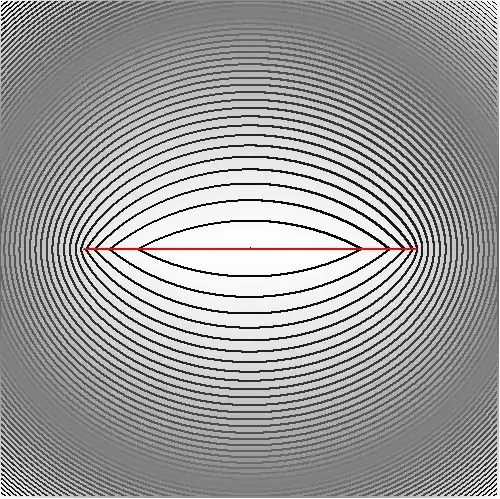Let $\,M \le N\,$ and $X$ be a finite set of $N$ reals $x_i\,$: $X = \{x_1,x_2, .. ,x_i, .. ,x_N\}\,$, $Y$ be a finite set of $M$ reals $y_j\,$: $Y = \{y_1,y_2, .. ,y_j, .. ,y_M\}\,$. In order to determine whether $X$ is a subset of $Y$, we could compare the elements: $X$ is a subset of $Y$, $\,X \subseteq Y\,$, if and only if for each of the $\,x_i\,$ one of them is equal to $\,y_j\,$ : $$ \quad ((x_1 = y_1) \vee (x_1 = y_2) \vee \cdots \vee (x_1 = y_j) \vee \cdots \vee (x_1 = y_M)) \\ \wedge ((x_2 = y_1) \vee (x_2 = y_2) \vee \cdots \vee (x_2 = y_j) \vee \cdots \vee (x_2 = y_M)) \\ \wedge \cdots \cdots \wedge \quad \\ \quad ((x_i = y_1) \vee (x_i = y_2) \vee \cdots \vee (x_i = y_j) \vee \cdots \vee (x_i = y_M)) \\ \wedge \cdots \cdots \wedge \quad \\ \quad ((x_N = y_1) \vee (x_N = y_2) \vee \cdots \vee (x_N = y_j) \vee \cdots \vee (x_N = y_M)) $$ $$ (X \subseteq Y) \Longleftrightarrow \bigwedge_{i=1}^N \left[ \bigvee_{j=1}^M \left(x_i=y_j\right) \right] $$ Because all $\,x_i\,$ and $\,y_j\,$ are real numbers, we can alsow write this as follows; a product of terms is zero, if and only if one (or more) of the factors is zero. $$ (X \subseteq Y) \Longleftrightarrow \bigwedge_{i=1}^N \left[ \prod_{j=1}^M \left(x_i-y_j\right) = 0\right] $$ And each of the terms is zero if and only if the sum of the squares of all of these terms is zero: $$ (X \subseteq Y) \Longleftrightarrow \sum_{i=1}^N \left[ \prod_{j=1}^M \left(x_i-y_j\right) \right]^2 = 0 $$ One can make this somewhat more computation friendly by implementing products as geometric means: take the $M$-th root of each of the terms. For the same reason, we shall implement the sum as an arithmetic mean. Furthermore the above can easily be generalized to vectors $(\vec{x}_i,\vec{y}_j)$. The we have at last, for the discrete case: $$ (X \subseteq Y) \Longleftrightarrow \sum_{i=1}^N \frac{1}{N} \left[ \prod_{j=1}^M \left|\vec{x}_i-\vec{y}_j\right|^2 \right]^{1/M} = 0 $$ In Wikipedia a definition is found of the Geometric Mean. And there is a relationship with the arithmetic mean of logarithms at that page: $$ {\displaystyle \left(\prod _{i=1}^{n}a_{i}\right)^{\frac {1}{n}}=\exp \left[{\frac {1}{n}}\sum _{i=1}^{n}\ln a_{i}\right];} \quad a_i > 0 $$ Together with the above then we have: $$ (X \subseteq Y) \Longleftrightarrow \sum_{i=1}^N \frac{1}{N} \exp\left[\frac{1}{M}\sum_{j=1}^M \ln(\left|\vec{x}_i-\vec{y}_j\right|^2)\right] = 0 $$ The following essential reading is needed, in order to be able to proceed.
Product integral
Namely for converting the discrete into the continuous: $$ (X \subseteq Y) \Longleftrightarrow \int_0^1 \exp\left(\int_0^1 \ln(\left|\vec{x}(t)-\vec{y}(u)\right|^2)\,dt\right)\,du = 0 $$ where a minor detail is restriction to the integration interval $[0,1]$ by parameter transformation.So far so good. Let's try now the simplest example possible, namely $\;\vec{x}(t)=t \; ; \; 0 \le t\le 1\;$ and $\;\vec{y}(u)=u \; ; \; 0 \le u\le 1\;$.
Then it is clear that $(X=Y$ and so $(X \subseteq Y)$ and $(Y \subseteq X)$. And our calculation effort is defined by proving that: $$ \int_0^1 \exp\left(\int_0^1 \ln\left(|t-u\right|^2)\,dt\right)\,du = \int_0^1 \exp\left(\int_0^1 \ln(\left|t-u\right|^2)\,du\right)\,dt = 0 \\ = \exp(-2)\int_0^1 u^{2u}(1-u)^{2(1-u)}\,du \approx 0.05378539284 $$ This is not by far the accuracy we did expect! I think it has something to do with evaluating the logarithm for $t=u$ but I'm not sure. What precisely is going on?
